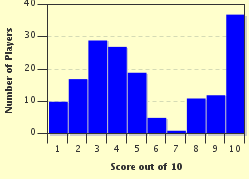Quiz Answer Key and Fun Facts
1. Albertus Magnus was one of the great scholars of the Roman Catholic Church, so much so that he was given the moniker "Albert the _____".
2. Famous geneticist Gregor Mendel (1822 - 1884) became a monk at least partly in order to gain the financial support of the church to further his studies. To which exalted and venerable order did he belong?
3. Credited with establishing the Buckfast bee strain during the 1950s, Karl Kehrle took what name on the eve of joining the Benedictine order early in his life?
4. Nothing sly about Gerbert d'Aurillac, a prolific scholar and teacher, who was better known to the world as which of the following?
5. Sister Mary Joseph Dempsey was a Catholic nun who entered the order of St. Francis at the age of 22, and was instrumental in the founding of which world-renowned centre?
6. Born in 1552, Matteo Ricci, an Italian Jesuit priest, looked east and was at the forefront in the establishment of which mission?
7. What familial commitment kept linguist and mathematician Maria Gaetana Agnesi, for whom the 'Witch of Agnesi curve' is named, from entering a nunnery?
8. Václav Prokop Divis of Bohemia (now the Czech Republic) was a canon regular, theologist and natural scientist. Though very devoted to life in the abbey, he was sent back to a parish where he was able to cultivate his love of science, so much so that he, quite frankly, made a discovery that greatly improved which of these inventions?
9. Georges Lemaître (1894 - 1966) is a Belgian priest who originated the Big Bang Theory of the universe. What unique happenstance allowed Lemaître to form this seemingly discordant theory?
10. Which 14th century inventor, known as God's Clockmaker, was elected Abbot of St Albans Abbey when in his mid-thirties?
Source: Author
VegemiteKid
This quiz was reviewed by FunTrivia editor
agony before going online.
Any errors found in FunTrivia content are routinely corrected through our feedback system.

